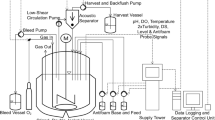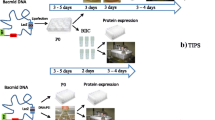Abstract
Factor Xa is a serine protease, whose high selectivity can be used to cleave protein tags from recombinant proteins. A fusion protein comprised of a self-activating form of factor X linked to a cellulose-binding module, saCBMFX, was produced in a stable transformed Sf9 insect cell line. The activity of the insect cell produced saCBMFX was higher than the equivalent mammalian cell produced material. A 1.5 l batch fermentation reached a maximum cell concentration of 1.6 × 107 cells ml−1 and a final saCBMFX concentration of 4 mg l−1. The production of saCBMFX by this cell line was also analyzed in a 1.5 l perfusion system using an ultrasonic filter as a cell-retention device for flow rates up to 3.5 l day−1. The cell-retention efficiency of an air backflush mode of acoustic filter operation was greater than 95% and eliminated the need to pump the relatively shear sensitive insect cells. In the perfusion system over 4 × 107 Sf9 cells ml−1 were obtained with a viability greater than 80%. With a doubling of viable cell concentration from 1.5 to 3 × 107 cells ml−1 the saCBMFX production rate was doubled to 6 mg l−1 day−1. The saCBMFX volumetric productivity of the perfusion system was higher than the batch fermentations (0.6 mg l−1 day−1) by an order of magnitude.
Similar content being viewed by others
References
Assouline Z., Shen H., Kilburn D.G. and Warren R.A. 1993. Production and properties of a factor X-cellulose-binding domain fusion protein. Protein Eng. 6: 787–792.
Chisti Y. 2001. Hydrodynamic damage to animal cells. Crit. Rev. Biotechnol. 21: 67–110.
Chu L. and Robinson D.K. 2001. Industrial choices for protein production by large-scale cell culture. Curr. Opin. Biotechnol. 12: 180–187.
Cook B.C., Rudolph A.E., Kurumbail R.G., Porche-Sorbet R. and Miletich J.P. 2000. Directed glycosylation of human coagulation factor X at residue 333. Insight into factor Va-dependent prothrombin catalysis. J. Biol. Chem. 275: 38774–38779.
Di Scipio R.G., Hermodson M.A., Yates S.G. and Davie E.W. 1977. A comparison of human prothrombin, factor IX (christmas factor), factor X (stuart factor) and protein S. Biochemistry 16: 698–706.
Fann C.H., Guarna M.M., Kilburn D.G. and Piret J.M. 1999. Relationship between recombinant activated protein C secretion rates and mRNA levels in baby hamster kidney cells. Biotechnol. Bioeng. 63: 464–472.
Garber K. 2001. Biotech industry faces new bottleneck. Nat. Biotechnol. 19: 184–185.
Gorenflo V.M., Angepat S., Bowen B.D. and Piret J.M. 2003. Optimization of an acoustic cell filter with a novel air-backflush system. Biotechnol. Prog. 19: 30–36.
Guarna M.M., Cote H.C., Kwan E.M., Rintoul G.L., Meyhack B., Heim J., MacGillivray R.T., Warren R.A. and Kilburn D.G. 2000. Factor X fusion proteins: Improved production and use in the release in vitro of biologically active hirudin from an inactive alpha-factor-hirudin fusion protein. Protein Expr. Purif. 20: 133–141.
Hegedus D.D., Pfeifer T.A., Hendry J., Theilmann D.A. and Grigliatti T.A. 1998. A series of broad host range shuttle vectors for constitutive and inducible expression of heterologous proteins in insect cell lines. Gene 207: 241–249.
Hegedus D.D., Pfeifer T.A., Theilmann D.A., Kennard M.L., Gabathuler R., Jefferies W.A. and Grigliatti T.A. 1999. Differences in the expression and localization of human melanotransferrin in lepidopteran and dipteran insect cell lines. Protein Expr. Purif. 15: 296–307.
Himmelspach M., Pfleiderer M., Fischer B.E., Plaimauer B., Antoine G., Falkner F.G., Dorner F. and Schlokat U. 2000. Recombinant human factor X: High yield expression and the role of furin in proteolytic maturation in vivo and in vitro. Thromb. Res. 97: 51–67.
Inoue K. and Morita T. 1993. Identification of o-linked oligosaccharide chains in the activation peptides of blood coagulation factor X. The role of the carbohydrate moieties in the activation of factor X. Eur. J. Biochem. 218: 153–163.
Keane J.T., Ryan D. and Gray P.P. 2003. Effect of shear stress on expression of a recombinant protein by chinese hamster ovary cells. Biotechnol. Bioeng. 81: 211–220.
Kunas K.T. and Papoutsakis E.T. 1990. The protective effect of serum against hydrodynamic damage of hybridoma cells in agitated and surface-aerated bioreactors. J. Biotechnol. 15: 57–69.
Kwan E., Guarna M.M., Boraston A.B., Gilkes N.R., Haynes C.A., Kilburn D.G. and Warren R.A. 2002. Self-activating factor X derivative fused to the C-terminus of a cellulose-binding module: Production and properties. Biotechnol. Bioeng. 79: 724–732.
Laemmli U.K. 1970. Cleavage of structural proteins during the assembly of the head of bacteriophage t4. Nature 227: 680–685.
Leytus S.P., Chung D.W., Kisiel W., Kurachi K. and Davie E.W. 1984. Characterization of a cDNA coding for human factor X. Proc. Natl Acad. Sci. USA 81: 3699–3702.
Ma N., Koelling K.W. and Chalmers J.J. 2002. Fabrication and use of a transient contractional flow device to quantify the sensitivity of mammalian and insect cells to hydrodynamic forces. Biotechnol. Bioeng. 80: 428–437.
McQueen A. and Bailey J.E. 1989. Influence of serum level, cell-line, flow type and viscosity on flow-induced lysis of suspended mammalian-cells. Biotechnol. Lett. 11: 531–536.
Merten O.-W. 2000. Constructive improvement of the ultrasonic separation device ADI 1015. Cytotechnology 34: 175–179.
Messier T.L., Pittman D.D., Long G.L., Kaufman R.J. and Church W.R. 1991. Cloning and expression in COS-1 cells of a full-length cDNA encoding human coagulation factor X. Gene 99: 291–294.
Pfeifer T.A., Hegedus D.D., Grigliatti T.A. and Theilmann D.A. 1997. Baculovirus immediate-early promoter-mediated expression of the zeocin resistance gene for use as a dominant selectable marker in dipteran and lepidopteran insect cell lines. Gene 188: 183–190.
Pfeifer T.A., Guarna M.M., Kwan E.M., Lesnicki G., Theilmann D.A., Grigliatti T.A. and Kilburn D.G. 2001. Expression analysis of a modified factor X in stably transformed insect cell lines. Protein Expr. Purif. 23: 233–241.
Rezaie A.R., Neuenschwander P.F., Morrissey J.H. and Esmon C.T. 1993. Analysis of the functions of the first epidermal growth factor-like domain of factor X. J. Biol. Chem. 268: 8176–8180.
Rudolph A.E., Mullane M.P., Porche-Sorbet R. and ‘Miletich J.P. 1997. Expression, purification and characterization of recombinant human factor X. Protein Expr. Purif. 10: 373–378.
Stanton C. and Wallin R. 1992. Processing and trafficking of clotting factor X in the secretory pathway. Effects of warfarin. Biochem. J. 284: 25–31.
Stanton C., Ross R.P., Hutson S. and Wallin R. 1996. Processing and expression of rat and human clotting factor-X-encoding cDNAs. Gene 169: 269–273.
Trampler F., Sonderhoff S.A., Pui P.W., Kilburn D.G. and Piret J.M. 1994. Acoustic cell filter for high density perfusion culture of hybridoma cells. Bio/Technology (N Y) 12: 281–284.
Wallin R. and Martin L.F. 1988. Early processing of prothrombin and factor X by the vitamin K-dependent carboxylase. J. Biol. Chem. 263: 9994–10001.
Zhang J., Collins A., Chen M., Knyazev I. and Gentz R. 1998. High-density perfusion culture of insect cells with a biosep ultrasonic filter. Biotechnol. Bioeng. 59: 351–359.
Author information
Authors and Affiliations
Corresponding author
Rights and permissions
About this article
Cite this article
Gorenflo, V.M., Pfeifer, T.A., Lesnicki, G. et al. Production of a self-activating CBM-factor X fusion protein in a stable transformed Sf9 insect cell line using high cell density perfusion culture. Cytotechnology 44, 93–102 (2004). https://doi.org/10.1007/s10616-005-0703-4
Received:
Accepted:
Issue Date:
DOI: https://doi.org/10.1007/s10616-005-0703-4




